Senior leaders under pressure as pupil numbers fall
Friday 19 September 2025
 This blog is the first of a two-part series considering the challenges impacting schools as they return in September 2025.
This blog is the first of a two-part series considering the challenges impacting schools as they return in September 2025.
Schools face a number of financial pressures as they return in September 2025, including declining pupil numbers and increasing salary costs. These factors raise wider questions about the implications for the quality of education and the levels of additional support provided by schools going forward.
But to what extent have school budgets been impacted, and how are schools responding to the current demographic decline?
This blog explores these questions by providing new insights into how school funding and demographic challenges are impacting school leaders, drawing on responses from over 350 senior leaders to NFER’s June 2025 Teacher Voice Omnibus Survey.
How are school finances faring?
School finances remained largely stable in 2024/25
Figure 1 presents senior leaders’ self-reported school budget position for the last two financial years*, based on responses to NFER’s Teacher Voice Omnibus Surveys in each reporting period. It shows that the financial positions for primary and secondary schools in 2024/25 were largely comparable to 2023/24.
A substantial minority of primary school senior leaders (at 21 per cent) said they had or were on track to have an in-year budget deficit that they expected to fund by a negative revenue balance in 2024/25 (as they had no reserves). In addition, two in every five primary and secondary schools had or were on track to have an in-year budget deficit that they expected to cover by depleting their reserves.
Figure 1 also suggests there has been a slight improvement in the financial positions of some secondary schools. The share of schools reporting in-year surpluses increased from 17 per cent in 2023/24 to 26 per cent in 2024/25.
However, the proportion of secondary school leaders reporting they had, or were on track to have, an in-year budget deficit funded via a negative revenue balance remained sizeable at nine per cent in 2024/25, almost unchanged compared to 2023/24.
In contrast, while not directly comparable, findings from a recent Schools Week investigation indicated that primary and secondary schools’ in-year budget positions declined on average in 2024/25.
One possible explanation for this difference is that, whilst school finances may have remained broadly stable on average, the size of deficits among schools running deficits may have increased.
Figure 1 Schools’ in-year budget status in the 2024/25 financial year compared to 2023/24, by phase, as self-reported by senior leaders
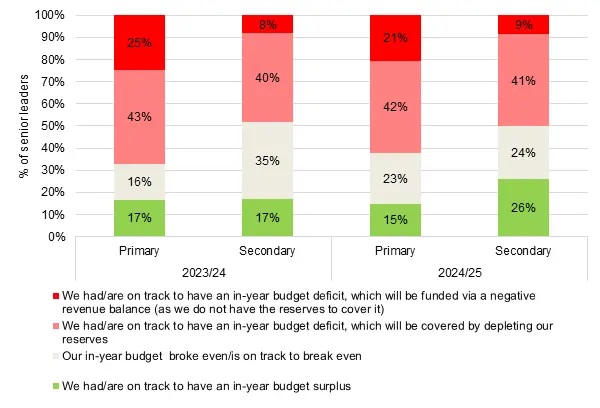
Source: NFER Teacher Voice Omnibus Surveys. The minimum number of responses given to an individual item in the 2024/25 survey was 127.
School budgets and provision are set to worsen next year
When asked to think about the financial year ahead, the majority of primary and secondary leaders in Figure 2 reported anticipating an in-year budget deficit for 2025/26. At the primary level, 71 per cent expect this outcome, a proportion largely unchanged since last year. For secondaries, the figure stands at 65 per cent, representing a marked deterioration in secondary schools’ budget outlooks compared to 2023/24.
However, senior leaders’ expectations may be overly pessimistic, as in previous Teacher Voice surveys. In fact, secondary leaders’ outlook for 2024/25 (on the left-hand side in Figure 2) proved to be more negative when compared with the actual 2024/25 outcomes in Figure 1. This caveat may also reflect the impact of corrective actions taken mid-year by schools and the Government to improve schools’ financial prospects.
For example, among schools anticipating an in-year budget deficit for 2025/26 (on the right-hand side in Figure 2), nearly three in four say they are likely to cut provision (such as by reducing the curriculum offer).
Figure 2 Schools’ expected in-year budget status at the end of the next financial year, by phase, as reported by senior leaders in 2023/24 and 2024/25

Source: NFER Teacher Voice Omnibus Surveys. The minimum number of responses given to an individual item in the 2024/25 survey was 127.
How are falling pupil numbers impacting on senior leaders?
Both primary and secondary school leaders are concerned about the pupil demographic decline
With schools’ costs relatively fixed in the short term yet funding tied to pupil numbers, shrinking pupil populations are likely to be a contributor to schools’ current financial pressures. For instance, as highlighted by previous NFER research, a loss of ten pupils may not justify cutting a class or teacher, but still causes a consequential drop in funding for the setting.
This is set to worsen, with the Department for Education (DfE) projecting there will be nearly 400,000 fewer pupils in state-funded primary and secondary schools by 2030, as illustrated in Figure 3.
Figure 3 State pupil number projections for England by school phase
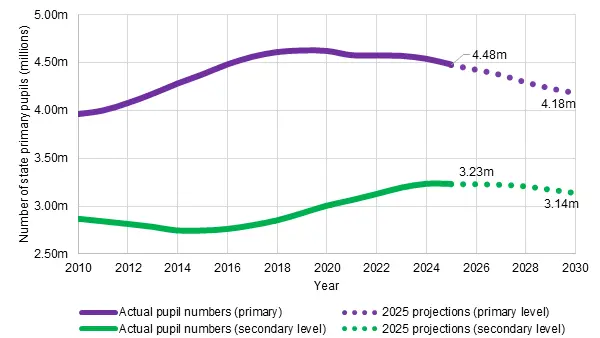
Source: National pupil projections by the DfE for the reporting year 2025
Indeed, more than three in five primary school leaders in 2024/25 who took part in our survey reported being somewhat or very concerned about the impact of declining pupil numbers on their settings (Figure 4).
More strikingly, around two in five secondary senior leaders said they were somewhat or very concerned about the looming impact on their schools. This is despite secondary pupil numbers not being forecast to dip for a couple more years.
Figure 4 Senior leaders' levels of concern in 2024/25 about the impact of falling pupil numbers on their school settings, by phase

Source: NFER Teacher Voice Omnibus Survey. The minimum number of responses given to an individual item was 140.
Our survey highlighted that the levels of concern about the impact of falling pupil numbers on schools do not markedly vary across key groups of settings, including whether a school is based in an urban or rural area and its disadvantage level – as measured by the proportion of pupils in a school eligible for Free School Meals (FSM).
Furthermore, primary school leaders across all regions of England report high levels of concern, especially in London. Regional differences are greater for secondaries: London’s secondary leaders are significantly more likely to report being at least somewhat concerned about falling pupil numbers, at 59 per cent, which is at least 21 percentage points more than anywhere else in England.
This is likely to reflect the fact that London is among the regions that have already seen the largest declines in primary pupil numbers to date.
How is the decline in pupil numbers affecting schools, and what are leaders doing about it?
Schools are making cuts in response to concerns about declining pupil numbers
We asked senior leaders who said they were at least slightly concerned about demographic change what actions they have taken in the last two years or are planning to take within the next two years to tackle the impact of falling pupil numbers on their settings.
Figure 5 shows that many senior leaders within this subgroup report having cut staff or provision as a response. Smaller but notable shares of senior leaders said they are considering doing so within the next two years.
The proportions of school leaders who have taken or plan to take these measures within two years may be somewhat overestimated, as some respondents may have reported reductions unrelated to falling pupil numbers during the indicated reporting period. In addition, figures only refer to responses from senior leaders who expressed concerns about demographic decline.
Reducing support staff was more commonly reported than reducing teaching staff. Among primary senior leaders in the subsample, 69 per cent reported having cut support staff; among secondary leaders, 65 per cent reported it.
A total of 41 per cent of primary and 58 per cent of secondary leaders who reported at least slight concerns about falling pupil numbers also reported having made cuts to teaching staff.
While primary school leaders (53 per cent) in the subgroup more typically reported having reduced extracurricular activities or out-of-class interventions, secondary senior leaders were similarly likely to report having narrowed the subject offer or curriculum (38 per cent) and cut extra-curricular activities or out-of-class interventions (33 per cent).
Figure 5 Steps senior leaders have taken or are considering taking in future to help manage the impact of falling pupil numbers on their school settings, by phase
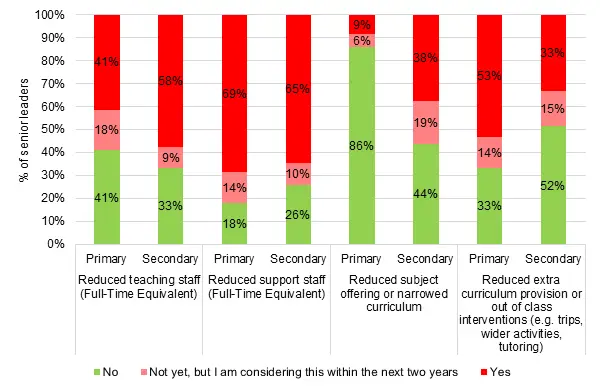
Source: NFER Teacher Voice Omnibus Survey. The minimum number of responses given to an individual item was 83. Question was asked to senior leaders who said they were at least slightly concerned about demographic change.
Increasing the use of mixed-age classes is also being considered as a mitigation among primary senior leaders who indicated at least slight concerns about declining pupil numbers.
As seen in Figure 6, 42 per cent of primary leaders in rural schools and 24 per cent in urban settings said they have increased the use of them in the last two years, revealing one way changes to pupil populations are reshaping classroom practices.
In addition, one in four primary school leaders at least slightly concerned about the impact of the pupil demographic decline said they have introduced nursery provision since 2022/23.
An extra nine per cent more indicated they may take these actions within the next two years. This suggests that some primary schools are repurposing underutilised spaces in response to changing demographics, as well as using nurseries as a means to attract more families.
Figure 6 Steps primary school leaders have taken or are considering taking in future to help manage the impact of falling pupil numbers on their school settings, by phase
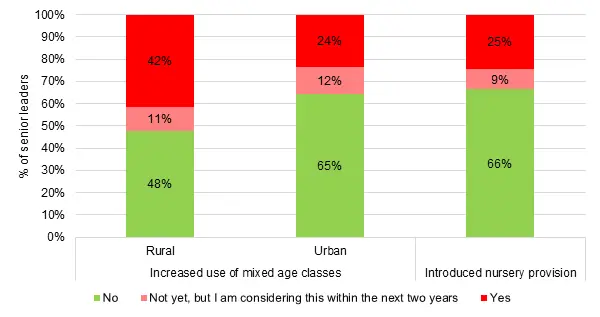
Source: NFER Teacher Voice Omnibus Survey. The minimum number of responses given to an individual item was 40. Question was asked to senior leaders who said they were at least slightly concerned about demographic change.
Schools are pooling more resources and functions
Schools are also adapting their operations as pupil numbers fall. Among schools that were at least slightly concerned about the impact of declining pupil numbers, nearly half of primary and secondary senior leaders reported they were sharing or were considering sharing staff, office functions or wider provision with other schools or trusts in future.
As shown in Figure 7, senior leaders in academies were more likely than those in local authority-maintained schools to be doing this or considering doing so. They were also more likely to have sought, or consider seeking, additional funding from their trust or local authorities compared to local authority-maintained schools.
At the primary level, 57 per cent of academy senior leaders reported having sought or considered seeking additional funding, compared to 41 per cent in local authority-maintained schools.
Figure 7 Steps senior leaders have taken or are considering taking in future to help manage the impact of falling pupil numbers on their school settings, by school type and phase
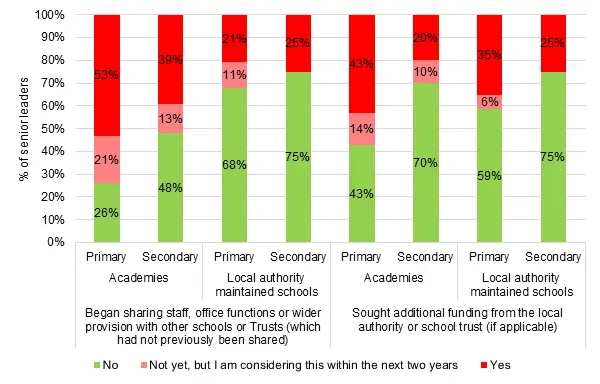
Source: NFER Teacher Voice Omnibus Survey. The minimum number of responses given to individual items was 69 among primary senior leaders in academies, 56 among secondary senior leaders in academies, 104 among primary senior leaders in local authority-maintained schools and 18 among secondary senior leaders in local authority-maintained schools. Question was asked to senior leaders who said they were at least slightly concerned about demographic change.
Senior leaders are turning to marketing and updating schools’ operational models
Approximately two-thirds of senior leaders concerned with the impact of declining pupil numbers also reported updating school marketing materials or changing their approach to open days, as Figure 8 illustrates.
Steps reported by senior leaders in open responses included leafletting new houses, advertising in newspapers, ramping up schools’ social media presence, organising playgroups for the community and offering more taster sessions.
Figure 8 Steps senior leaders have taken or are considering taking in future to help manage the impact of falling pupil numbers on their school settings, by phase

Source: NFER Teacher Voice Omnibus Survey. The minimum number of responses given to an individual item was 85. Question was asked to senior leaders who said they were at least slightly concerned about demographic change.
Several senior leaders indicated in open responses that they are taking additional steps to help manage the impact of falling pupil numbers on their settings. These steps included, for example, seeking new income sources through charitable funding, renting school spaces, setting up specialist provision for pupils with Special Educational Needs and Disabilities (SEND) to attract more pupils, and changing admissions processes.
Other senior leaders explained they are prioritising contractual arrangements that give them more flexibility to reduce costs, such as fixed-term contracts or paying overtime, rather than increasing staff’s core working hours.
A sizeable minority of senior leaders are planning to merge or close their schools
Among senior leaders who expressed at least slight concern about the impact of declining pupil numbers, 20 per cent at the primary level and ten per cent at the secondary level reported they had explored, or were considering exploring, the possibility of merging with another school.
At the same time, seven per cent of primary and six per cent of secondary school leaders in the same subsample said that they had discussed, or were considering discussing, the possibility of closing their schools.
These figures should be treated with caution, as falling enrolments would reasonably be expected to prompt more widespread discussions about potential mergers or closures.
However, it is possible that such discussions fall more within the remit of local authority and trust leaders, rather than individual schools, in which case, merging and closing schools may be more commonly explored than our school-level data suggests.
While schools are adjusting to the demographic change, more system-level support and planning are likely to be required
The financial landscape remains challenging for schools in England as they return in September 2025. With falling pupil numbers contributing to this deterioration, both primary and secondary schools are already taking steps to manage the impact or expect to be in the next two years.
Many of these adjustments, such as cuts to staffing and provision, alongside changes in how schools are run, are likely to affect the quality of education and pupils’ experiences of school.
While senior leaders are taking proactive steps to mitigate the impact of falling pupil numbers on their settings, if the forecast declines in pupil numbers are borne out, it is likely that more drastic steps will be needed across the school system.
As this unfolds, it is crucial that local and national governments take a proactive role in planning for and supporting schools through these structural changes.
The next blog in this two-part series further explores the challenges faced by schools as they return in September 2025 by investigating the levels of pupil needs and support received.
Footnote
*The 2024/25 financial year ended in March 2025 for local authority-maintained schools and in August 2025 for academies.
